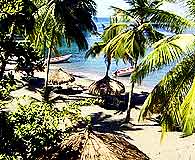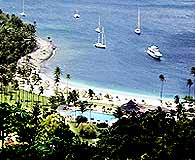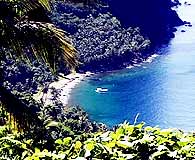| W E L C O M E T O M Y S T L U C I A B E A C H E S |
|
 |
Anse Chastenet Beach |
 |
|
 |
|
Some
hotels make access difficult, but by law there is a public path to
the beach or you may reach it by boat.
Chairs, umbrellas etc. are "free" for registered guests only. For
a small fee, usually about US$3 - US$5 per day, they may be hired
by non-registered guests. |
|
Northwest Coast
Pigeon Island:
The Causeway connects the Island landmark of Pigeon Island National Park
to the mainland. Once the
home of Amerindians, a hideout for pirates and a military base for the
British, it's now a recreational area with beaches and areas for
picnicking. Labrelotte Bay: A very nice sandy beach situated between the East Winds Inn and the Windjammer Landing. Marigot Bay: this secluded bay is everyone's fantasy of the ultimate Caribbean cove. Bordered on three sides by three steep emerald hills, the bay is skirted by coconut palms. Inside the inlet, there are deserted beaches and a well-hidden resort, as well as anchorage for yachts. An ideal place to relax on one of the deserted beaches or anchor your yacht in this peaceful cove. |
|
South Coast Many of the beautiful beaches in this area are only available by boat Anse Cochon: Accessible only by boat, the black volcanic sands and calm waters make it a romantic hideaway and shallow reefs provide hours of snorkelling fun. Anse Chastanet: Just off the coast of Anse Chastanet beach is the popular marine reserve that has some of the best snorkelling and diving on the island. Soufriere: North of the city there is a long stretch of dark sandy beach. Between the palm trees you have a grandiose view of one of the Pitons. The beach is mostly used by local people. Cas En Bas: One of the pre-eminent places for wind surfing. The last part of the road to the beach is in very bad condition and it is as fast to walk down to the beach as it is to drive. There are constant on shore trade winds. At the Turtle Reef Bar, the only wooden house next to the stretched white sandy beach, you can hire a wind surf board and take wind surfing lessons. There are also kayaks for hire. During the summer months, the bar can be closed for a period of several weeks. Anse de Sables: An easy to reach, beautiful but windy, white sandy beach looking out over the Maria Islands. This is one of the most popular places for wind surfing, as there are constant on shore trade winds. Close to the 'The Reef' bar and restaurant you can hire wind surf boards. The wind surf centre of Club Aquarius is also located here. This beach is recommended for sun-worshippers. Jalousie: The Hilton imported fine white sand to cover the black sand on their beach that can make the water cloudy, but it is a most beautiful bay. You can feed the fish from the pontoon. Anse Des Pitons: Relax at the foot of The Pitons on this stunning crescent-shaped beach. At certain points of the beach you're actually between The Pitons. Anse De Sable: As one of the most beautiful and long beaches in St. Lucia, it's amazing that it's not overly developed or populated, and it's easy to access if you don't mind the drive. |
|
East Coast The Atlantic east coast of the island has heavy surf beating against the cliffs, so are unsuitable for swimming, but the beaches look spectacular and well worth a visit despite being so isolated that they are difficult to get to without 4-wheel drive and local guidance. They are a refreshing change from the west coast, but do not go here if you wish to swim. This area contains important habitats and nesting places for the island's wildlife, so are ideal for the naturalist and bird watchers. Donkey Beach: An hour's walk from Gros Islet, but well worth the trek. The wild scenery is open and windy. Unlike any other beach on the island. Anse Comerette: Accessible from Monchy. Here you'll find solitary bluffs and wind-swept beaches. Dauphin Beach: Indian stone-carvings are the main attraction at this beach only accessible by jeep from Monchy. When you reach the beach, wade across the river to the clearing below the brush. Walk 50 metres, and you'll discover elongated stones with repeated depressions. Walk further on, and you'll see a stone pillar that seems to depict a family of three. Unfortunately, the stones have been damaged. Walk a few more meters, and you'll see the ruin of the colonial church tower that is the only remnant of the town that was destroyed in the 1795 St. Lucia French Revolution.
Anse Louvet: A 3-hour walk from Desbarra
(you cannot drive here) will bring you to a stunning secluded
beach. Before you set out for the beach, ask locals about the
conditions of the roads since they change often. Be sure to
take lots of water with you. Once there, you'll see waves beat
against rugged cliffs that create a spectacular blowhole. If
you follow the river into the main valley, it will bring you
to a tall waterfall. See if you can spot the wild vanilla that
grows here. The La Sorcière
mountains make a wall between the sea and the inland giving the
surroundings a special distinction. |
|
Activities
Beaches
Calendar
Diving
Ecology
Exploring
Geography
Island Info
History
Home
MDDM
Parrots
People
Restaurants &
Nightlife
St Lucia
St Lucia
Hotels Tourist info Transportation Travel Tips Video Weddings Whales & Dolphins Wildlife Visit one of our other Caribbean Island destinations ANTIGUA BARBADOS GRENADA ST KITTS ST LUCIA TOBAGO CYPRUS FLORIDA GOSPORT KENYA NERJA |